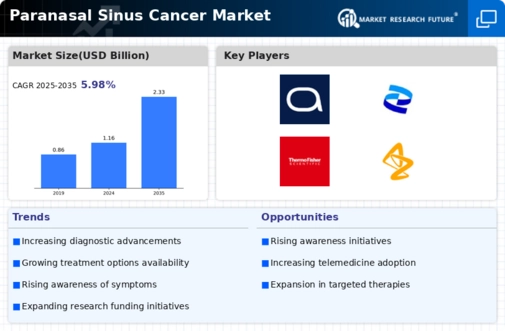Market Growth Projections
The Global Paranasal Sinus Cancer Market Industry is poised for substantial growth, with projections indicating a market size of 1.16 USD Billion in 2024 and an anticipated increase to 2.33 USD Billion by 2035. This growth trajectory suggests a compound annual growth rate (CAGR) of 6.56% from 2025 to 2035. Factors contributing to this growth include rising incidence rates, advancements in diagnostic technologies, and increased investment in cancer research. The market dynamics reflect a robust response to the evolving needs of patients and healthcare systems, indicating a promising future for stakeholders in the industry.
Growing Investment in Cancer Research
The Global Paranasal Sinus Cancer Market Industry is benefiting from increased investment in cancer research and development. Governments and private organizations are allocating substantial funds to explore novel treatment modalities and improve existing therapies. This influx of capital is fostering innovation in drug development and personalized medicine, which may lead to more effective treatment options for paranasal sinus cancer. As research progresses, the market is anticipated to experience a compound annual growth rate (CAGR) of 6.56% from 2025 to 2035. This investment trend is likely to enhance the overall landscape of the industry, providing hope for better management of the disease.
Advancements in Diagnostic Technologies
Technological advancements in diagnostic methods are significantly influencing the Global Paranasal Sinus Cancer Market Industry. Innovations such as advanced imaging techniques, including MRI and CT scans, enhance the accuracy of early detection, which is crucial for improving patient outcomes. The integration of artificial intelligence in imaging analysis is also emerging as a game-changer, potentially leading to earlier diagnoses. As the market evolves, these advancements are expected to drive growth, with projections indicating a market size of 2.33 USD Billion by 2035. Enhanced diagnostic capabilities may lead to increased patient referrals and treatment initiation, further propelling the industry.
Emerging Treatment Options and Therapies
The Global Paranasal Sinus Cancer Market Industry is witnessing the emergence of novel treatment options and therapies, which are reshaping the landscape of patient care. Innovations in immunotherapy and targeted therapies are providing new avenues for treatment, potentially improving survival rates and quality of life for patients. As these therapies gain traction, they are likely to attract significant interest from healthcare providers and patients alike. The market is projected to grow substantially, reaching 2.33 USD Billion by 2035, as these advanced treatment modalities become more widely available and integrated into clinical practice.
Rising Awareness and Education Initiatives
Awareness campaigns and educational initiatives regarding paranasal sinus cancer are gaining momentum, contributing positively to the Global Paranasal Sinus Cancer Market Industry. Organizations and healthcare providers are increasingly focusing on educating the public about risk factors, symptoms, and the importance of early detection. This heightened awareness is likely to encourage individuals to seek medical evaluation sooner, leading to earlier diagnoses and improved treatment outcomes. As a result, the market is expected to expand, with a projected size of 1.16 USD Billion in 2024. The ongoing efforts in public health education are crucial for driving patient engagement and fostering a proactive approach to health.
Increasing Incidence of Paranasal Sinus Cancer
The Global Paranasal Sinus Cancer Market Industry is witnessing a rise in the incidence of paranasal sinus cancer, which is attributed to various factors including environmental exposures and occupational hazards. As per recent data, the global incidence rate is projected to increase, leading to a heightened demand for diagnostic and therapeutic solutions. This trend is likely to contribute to the market's growth, with the industry expected to reach 1.16 USD Billion in 2024. The increasing awareness regarding the disease and its symptoms is also driving more patients to seek medical attention, thereby expanding the market further.







Leave a Comment